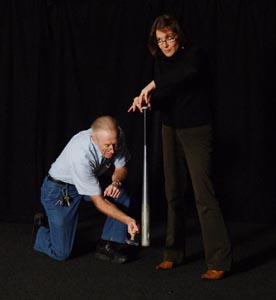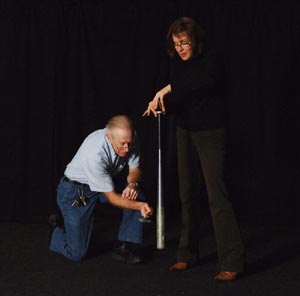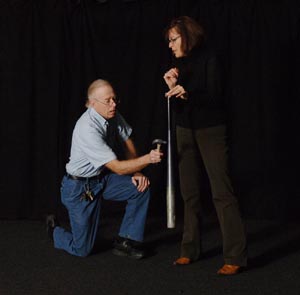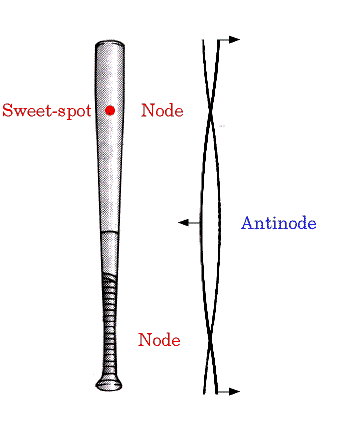
Looking for the sweet spot, Linda feels for vibrations as Paul taps the bat gently with a hammer.
Here Paul hits the antinode and Linda feels vibration. Click to enlarge.
The Node of Vibration

Introduction
When a baseball collides with a baseball bat it can set the bat vibrating, just like a hammer when it strikes the bar of a marimba. When the bat vibrates in its lowest frequency mode, known as the fundamental frequency mode, there are places where the bat does not vibrate at all, named the node, and places where it vibrates a lot, named anti-nodes. If a ball strikes a bat at the antinode the bat will vibrate a lot in this pattern, if the ball strikes a node the bat doesn't vibrate much at all.
Material
• A bat
• A hammer (A rubber mallet will not dent the bat)
• A friend
To Do and Notice
To find the "sweet spots" on a baseball bat known as the node of vibration, hold the bat, hanging down, loosely between your thumb and index finger, just below the knob on the bat's handle. Have a friend tap the bat gently with a hammer, starting at the fat end and moving toward the handle. (You can also do it yourself, although it's easier and more fun with a friend.) You should feel a vibration in your fingers whenever the bat is struck, except when the "node" is hit; then you'll feel nothing. You may also notice a slightly different sound when the node is struck.



Illustration showing the second harmonic vibration pattern of the
bat.
What's Going On ?
When you hit a ball just right, you've hit it on one of the two "sweet spots" of the bat. One of these sweet spots relates to vibration. Whenever an object is struck, it vibrates in response. These vibrations travel in waves up and down the length of the object. At one point, called "the node," the waves always cancel each other out. If you hit the ball on the bat's node, the vibrations from the impact will cancel out, and you won't feel any stinging or shaking in your hand. Since little of the bat's energy is lost to vibrations when this spot is hit, more can go to the ball.
The node sweet-spot differs from the "center of percussion" sweet-spot. When a ball hits the node, you don't feel any vibration in your hand. When it hits the center of percussion, your hand doesn't feel any force pushing against it.
Notice we had you hold the bat at the antinode of the handle end to most easily feel the vibration
Going Further
A ten foot long piece of 1/2 inch diameter PVC pipe (Schedule 40) can be held horizontally in two hands spaced wide apart and vibrated up-and-down to excite the second harmonic vibration. Try oscillating it at different frequencies to find resonance.

Notice the two nodes where the rod does not move up and down much located outside of Linda's hands. There are antinodes at the ends of the rod and in the middle. The sweet-spot of vibration of a bat occurs when a ball hits the node of vibration.
Bat Node 2
Hear the node of a bat as you tap it with a mallet.
Material
Assembly
Tightly tape an index card to the knob on the end of the bat.
To Do and Notice
Hold the bat a few inches down below the knob.
Tap the bat with the mallet at the far end as shown in the top photo.
Listen to the sounds. The sound is more audible because the index card acts as a sounding board.
Tap the bat at different places up and down the length of the bat and notice how the sound changes.
When the sound is quietest you are tapping the bat at a node.
What's Going On?
When the ball collides with the bat at a node the bat vibrates less, and so less energy is lost into the bat from the collision of the ball and the bat.
With more energy the ball travels further.
Going further
There are several different patterns of vibration, called modes of oscillation, of the bat. Each mode has it's own nodes.
In a bat a couple of these nodes are close to the same location.This location is a "sweet spot."
|
Scientific Explorations with Paul Doherty |
|
2 May 2008 |